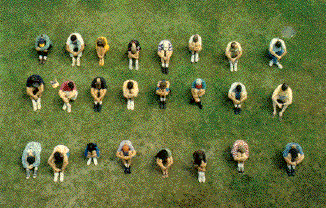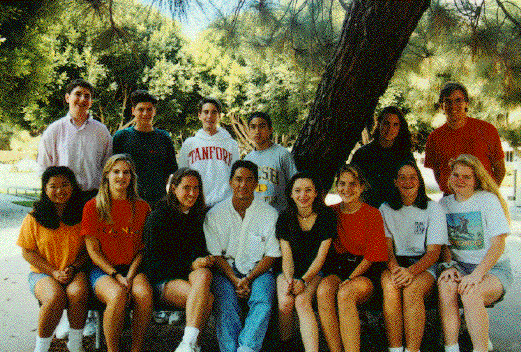
Student Programs: Out of the Classroom and into the World of Science
- Interactive Programs and Field Trips
- Science Fairs
- Research Experience for High School Students
- Computer-based Learning
- Talks from Prominent Scientists
Much of the world of science is found outside the traditional classroom-outdoors at a distant field site, in a planetarium, in a laboratory, or on a computer screen. Fortunately, students are natural curiosity seekers who are eager to discover this world. STC programs for K-12 students capitalize on this curiosity by allowing them to learn scientific concepts through discovery. STC researchers help further maintain student interest as mentors. The researchers work with students on complex problems, developing new ways of demonstrating scientific concepts with each student.
Interactive Programs and Field Trips
STC programs challenge students to examine scientific concepts from different perspectives. Researchers at the Center for Advanced Liquid Crystalline Optical Materials have shown students how liquid crystals display physical and optical phenomena that easily exemplify fundamental scientific concepts.
 At the "Creative Connections Institute" at Kent
State University, ALCOM staff taught a course in liquid crystals to
high school students. In a presentation at the end of the course, the
students demonstrated concepts in liquid crystal research by
physically arranging themselves to simulate molecules in the various
phases found in liquid crystals.
At the "Creative Connections Institute" at Kent
State University, ALCOM staff taught a course in liquid crystals to
high school students. In a presentation at the end of the course, the
students demonstrated concepts in liquid crystal research by
physically arranging themselves to simulate molecules in the various
phases found in liquid crystals.
 On a grander scale, The Geometry Center
helped to introduce concepts in engineering and mathematics to more
than 10,000 K-12 students in the "Building a New World" project. The
students helped to erect a scale model of the Earth that was 42 feet
in diameter and weighed 6,000 pounds.More than 1,620 plastic
triangular panels covered the globe's aluminum framework. The sheer
proportions of this project, both in the number of people involved and
the size of the model, enlightened the students about the tremendous
challenges that humans can overcome with the help of science,
engineering, and mathematics. The project was supported by the center
and other departments at the University of Minnesota.
On a grander scale, The Geometry Center
helped to introduce concepts in engineering and mathematics to more
than 10,000 K-12 students in the "Building a New World" project. The
students helped to erect a scale model of the Earth that was 42 feet
in diameter and weighed 6,000 pounds.More than 1,620 plastic
triangular panels covered the globe's aluminum framework. The sheer
proportions of this project, both in the number of people involved and
the size of the model, enlightened the students about the tremendous
challenges that humans can overcome with the help of science,
engineering, and mathematics. The project was supported by the center
and other departments at the University of Minnesota.
The Center for Magnetic Resonance Technology for Basic Biological Research organizes a summer science camp in collaboration with Urbana-Champaign, Illinois elementary schools. Every morning for four weeks, 30 children in grades 2-5 are involved in science activities, together with two teachers and six undergraduate students from the University of Illinois. Each year, six of these children are given scholarships for the program through the center's Project SEARCH after-school program at the Don Moyer's Boys and Girls Club in Urbana.
Several STCs have developed innovative ways of helping K-12 students understand complex scientific phenomena firsthand. The Center for Ultrafast Optical Science has science programs for students from kindergarten all the way to 12th grade. K-5 science camps encourage 400 largely minority students to study science in greater depth through week-long sessions of experiments, demonstrations, and tours. For middle school students, the center provides mentors, career choice panels, tours at university and industrial sites, and hands-on activities in lasers, optics, and electronics. A summer apprenticeship program offers mostly minority high school students eight weeks of practical experience that gives them a feel for work in research while enhancing their mathematics and science skills. Many of these students have gone on to attend the University of Michigan.
Science Fairs
Some of the country's most prominent scientists began their careers by participating in local science fairs. The STCs continue to support science fairs as popular venues for scientific interests. Science fairs create an atmosphere that challenges students to learn about new things and rewards them for their efforts by displaying their work in public. The Center for the Analysis and Prediction of Storms and Oklahoma City Community College host an annual competition entitled "Meteorological Applied Problem Solving," in which students try to predict the weather using real data collected by the center. The competition involves 80 school districts and 400 students in Oklahoma. Another well-received fair is the "Project SEARCH Science Fair," sponsored by the Center for Magnetic Resonance Technology for Basic Biological Research. The fair is part of a larger effort in which faculty and undergraduate students from the University of Illinois work with local-area K-6 students and their teachers on weekly hands-on science activities. The fair's location at the university's Beckman Institute for Advanced Science and Technology prompted one journalist to note, "It's not often that eight-year-olds get to exhibit their science projects at a world-renowned scientific institute."A yearly science fair with 90 student entries in 1993 was a development of one of the Center for Microbial Ecology's affiliated inner-city high schools. One finalist in the competition went on to participate in the Metropolitan Detroit Science Fair and was qualified to participate in the International Science Fair.
Research Experience for High School Students
Research experience for high school students provides both a means for students to learn more about advanced scientific concepts and a meaningful way to introduce them to career opportunities in scientific research. Research "typical of STC scientists" is offered to high school students in the "Careers in Applied Science and Technology" program at the Center for Light Microscope Imaging and Biotechnology. Students participate in the daily work of the center's scientists, learn how to communicate their research findings to the public, and even put together a magazine documenting the program. Teachers work side-by-side with their students and STC staff.The Center for Quantized Electronic Structures (QUEST) offers similar experiences in a six-week program for high school students and their teachers. More than 40 students and three teachers have worked alongside center staff as assistants on QUEST research projects. Through this experience, the students learn methods that are important to know for research, such as computer programming and literature searches, and learn various techniques to investigate the surface structure and chemistry of semiconductors and to characterize electron waveguides.

The Apprentice Researcher at QUEST summer
program at the Center For Quantized Electronic Structures, now in its
forth year, provides high school students and teachers with the
oportunity to work with graduate student mentors on laboratory
research projects.
For high school students interested in geophysics, the Center for High Pressure Research (CHiPR) offers research experience at this advanced research facility. One participating high school student, Job Thomas Rijssenbeek, was chosen as one of 40 national finalists in the 53rd annual Westinghouse Science Talent Search. Job worked with CHiPR's John Parisi on a project that examined novel tin sulfides.
Computer-based Learning
In addition to hands-on activities and research, STC programs use computers to make learning interesting. The Center for Computer Graphics and Scientific Visualization introduced important concepts in computer graphics to high school students through summer programs in Utah and New York State. The fourth annual Utah Summer Computing Institute, a five-week program sponsored jointly by the STC, the NSF Young Scholars Program, and the University of Utah, immersed 41 students from 32 high schools in the challenges of three-dimensional geometric modeling and expert systems. With the University of Utah's stereolithography machine, students manufactured selected three-dimensional models from their computer designs. In Ithaca, New York, the center sponsored two weeks of a six-week summer session for 96 high school students in the Cornell University Department of Architecture. Students explored the role of computer technology in future professional design practice and created three-dimensional interpretations of paintings by modern artists such as Klee and Mondrian. The center also brings the excitement of computer graphics to elementary and middle school visitors. Children can perform for digital video, steer an interactive walk through a building displayed on a screen, and watch their own image gradually change into a friend's image using a "morphing" tool.The STCs have used computer technology to bring scientific data directly to the classroom. Students at four southern California high schools are using a PC-based real-time earthquake detection and reporting system, thanks to the Southern California Earthquake Center. The system allows students to access center earthquake data that they can analyze and use for simulated social response planning. The Remote Access Astronomy Project (RAAP) is a program of the Center for Particle Astrophysics that places high- quality images and image processing techniques into computer workstations in secondary school classrooms. Using images from the Voyager, IRAS, COBE, Hubble Space Telescope, and many other sources, curricula have been developed that are relevant to current topics and are easily downloaded through RAAP's computerized dial-in data distribution system.
Other centers have distributed helpful software to K-12 science classes. The Center for High Pressure Research has distributed a visually exciting interactive seismic program to many high school earth science teachers. The center is collecting available public domain software, shareware, and other applicable software to build a software resource library. It also provides current scientific information to secondary schools in the form of up-to-the-minute seismic data to which they would normally not have access.
Talks from Prominent Scientists
STCs host leading scientists who talk to students about their own personal and professional perspectives on science. The Center for Engineering Plants for Resistance Against Pathogens brings K-12 students in northern California to the center and to the University of California at Davis to hear talks from noted scientists from around the world. In a well-received talk, Paul Williams described "fast plants" and "bottle biology." The "Frontiers Series" sponsored by the Center for Molecular Biotechnology brings current topics in science, technology, and medicine to students, teachers, and administrators. More than 200 students and teachers attend each presentation. Scientists focus on exciting topics that have implications for social policy. Students have the opportunity to interact with speakers and members of the STC at a reception after each presentation.K-12 Education
Sites & Affiliations | Leadership | Research & Applications | Major Accomplishments | FAQ | Search | Knowledge & Technology Transfer | Calendar of Events | Education & Outreach | Media Resources | Technical Reports & Publications | Parallel Computing Research Quarterly Newsletter | News Archives | Contact Information
| Hipersoft | CRPC |
© 2003 Rice University
|